Modeling and Analysis of Wave Energy Harvester with Symmetrically Distributed Galfenol Cantilever Beams
Abstract
1. Introduction
2. Wave Energy Harvester Design
2.1. Design of Energy Harvesting Methods
2.2. Overall Structural Design
3. Establishment of Mathematical Model for Wave Energy Harvester
3.1. Dynamical Analysis of the Wave Energy Harvester
3.2. Modeling and Simulation of Galfenol Cantilever Beams
3.3. Calculation and Analysis of Induced Electromotive Force of the Wave Energy Harvester
4. Experimental Verification
4.1. Analysis of Experimental Verification Results for the Transient Dynamic Simulation
4.2. Analysis of Experimental Validation of the Wave Energy Harvester Mathematical Model
5. Conclusions
- (1)
- In order to solve the problem of energy supply difficulty and high cost in marine wireless sensor networks, a wave energy harvester with a cylindrical, multi-cantilever beam symmetrically distributed structure was designed using the magnetostrictive material Galfenol sheet. The energy harvester is designed to float on the water’s surface without capsizing, utilizing a float board and gravity anchor. This design ensures the device’s stability in harsh ocean environments and maximizes energy harvesting efficiency.
- (2)
- The dynamic equation of the device was established to determine the motion displacement of the device under wave excitation. The transient dynamic simulation analysis module in ANSYS Workbench was used to simulate and analyze the motion characteristics of the Galfenol cantilever beam, and to determine its deformation law. Based on the Jiles-Atherton hysteresis theory model, the mathematical model of the strain displacement and induced electromotive force of the Galfenol cantilever beam was established.
- (3)
- The error between the transient dynamic simulation results and the experimental results of the cantilever beam was kept within 7%. The voltage that could be generated by the energy harvester was 30.04 mV, and the power output was 12.88 μW. The error between the theoretical and experimental values of the energy conversion mathematical model was about 15%, which verifies the validity of the device mathematical model.
Author Contributions
Funding
Institutional Review Board Statement
Informed Consent Statement
Data Availability Statement
Conflicts of Interest
References
- Shalby, M.; Dorrell, D.G.; Walker, P. Multi–chamber oscillating water column wave energy converters and air turbines A review. Int. J. Energy Res. 2019, 43, 681–696. [Google Scholar] [CrossRef]
- Von Schuckmann, K.; Le Traon, P.-Y.; Alvarez-Fanjul, E.; Axell, L.; Balmaseda, M.; Breivik, L.-A.; Brewin, R.J.W.; Bricaud, C.; Drevillon, M.; Drillet, Y.; et al. The copernicus marine environment monitoring service ocean state report. J. Oper. Oceanogr. 2016, 9, 235–320. [Google Scholar] [CrossRef]
- Zhang, D.; Li, W.; Lin, Y. Wave energy in China: Current status and perspectives. Renew. Energy 2009, 34, 2089–2092. [Google Scholar] [CrossRef]
- Yang, J.; Zhang, D.-H.; Chen, Y.; Liang, H.; Tan, M.; Li, W.; Ma, X.-D. Design, optimization and numerical modelling of a novel floating pendulum wave energy converter with tide adaptation. China Ocean Eng. 2017, 31, 578–588. [Google Scholar] [CrossRef]
- Henderson, R. Design, simulation, and testing of a novel hydraulic power take-off system for the pelamis wave energy converter. Renew. Energy 2006, 31, 271–283. [Google Scholar] [CrossRef]
- Shao, H.; Wen, Z.; Cheng, P.; Sun, N.; Shen, Q.; Zhou, C.; Peng, M.; Yang, Y.; Xie, X.; Sun, X. Multifunctional power unit by hybridizing contact-separate triboelectric nanogenerator, electromagnetic generator and solar cell for harvesting blue energy. Nano Energy 2017, 39, 608–615. [Google Scholar] [CrossRef]
- Masoumi, M.; Wang, Y. Repulsive magnetic levitation-based ocean wave energy harvester with variable resonance: Modeling, simulation and experiment. J. Sound Vib. 2016, 381, 192–205. [Google Scholar] [CrossRef]
- Viet, N.V.; Wang, Q. Ocean wave energy pitching harvester with a frequency tuning capability. Energy 2018, 162, 603–617. [Google Scholar] [CrossRef]
- Fan, F.-R.; Tian, Z.-Q.; Lin Wang, Z. Flexible triboelectric generator. Nano Energy 2012, 1, 328–334. [Google Scholar] [CrossRef]
- Liu, H.F. Wave Energy Generation Device Based on Columnar Super Magnetostrictive Materials. CN109039157A, 18 December 2018. [Google Scholar]
- He, Z.B.; Bai, G.; Xue, G.M.; Rong, C.; Zheng, J. Research progress of magnetostrictive vibration energy recovery technology. Mach. Tools Hydraul. 2019, 47, 144–150. [Google Scholar]
- Zhao, X.; Lord, D.G. Application of the villari effect to electric power harvesting. J. Appl. Phys. 2006, 99. [Google Scholar] [CrossRef]
- Lundgren, A.; Tiberg, H.; Kvarnsjo, L.; Bergqvist, A.; Engdahl, G. A magnetostrictive electric generator. IEEE Trans. Magn. 1993, 29, 3150–3152. [Google Scholar] [CrossRef]
- Yoo, J.-H.; Flatau, A.B. A bending-mode galfenol electric power harvester. J. Intell. Mater. Syst. Struct. 2012, 23, 647–654. [Google Scholar] [CrossRef]
- Ghodsi, M.; Ziaiefar, H.; Mohammadzaheri, M.; Al-Yahmedi, A. Modeling and characterization of permendur cantilever beam for energy harvesting. Energy 2019, 176, 561–569. [Google Scholar] [CrossRef]
- Mirzamohamadi, S.; Sheikhi, M.M.; Karafi, M.R.; Ghodsi, M.; Ghorbanirezaei, S. Novel contactless hybrid static magnetostrictive force-torque (chsmft) sensor using galfenol. J. Magn. Magn. Mater. 2022, 553, 168969. [Google Scholar] [CrossRef]
- O’Shea, M.J. Harmonic and anharmonic behaviour of a simple oscillator. Eur. J. Phys. 2009, 30, 549. [Google Scholar] [CrossRef]
- Scheibye-Knudsen, K.; Ellegaard, C.; Bundgaard, F.; Sams, T. Sand ripples under water with complex wave motion. Phys. Rev. E 2005, 72, 016209. [Google Scholar] [CrossRef]
- Wang, X.; Li, D.; Bai, Z.G.; Qi, Z.; Wu, H. Research on the fine survey and distribution characteristics of wave energy resources around sea islands. Mar. Lakes Marshes 2020, 51, 1257–1266. [Google Scholar]
- Zhu, Y.R. Analysis of the scope of application of several wave theories. Coast. Eng. 1983, 02, 11–27. [Google Scholar]
- Zou, C.L. Water Wave Theory and Its Applications; Science Press: Beijing, China, 2005. [Google Scholar]
- Han, B.; Chu, J.; Xiong, Y.; Fei, Y. Modeling and simulation of the novel wave energy piezoelectric generator. In Proceedings of the 2011 International Conference on Electrical and Control Engineering, Yichang, China, 16–18 September 2011; pp. 1621–1624. [Google Scholar]
- DelBalzo, D.R.; Chen, H.M.; Hughes, B.; Cranford, C.; Stewart, S. Drag body design in support of wave energy harvesting. In Proceedings of the Oceans 2010 Mts/IEEE Seattle, Seattle, WA, USA, 20–23 September 2010; pp. 1–6. [Google Scholar]
- Jiles, D.C.; Li, L. A new approach to modeling the magnetomechanical effect. J. Appl. Phys. 2004, 95, 7058–7060. [Google Scholar] [CrossRef]
- Jiles, D.C.; Thoelke, J.B. Theory of ferromagnetic hysteresis: Determination of model parameters from experimental hysteresis loops. IEEE Trans. Magn. 1989, 25, 3928–3930. [Google Scholar] [CrossRef]
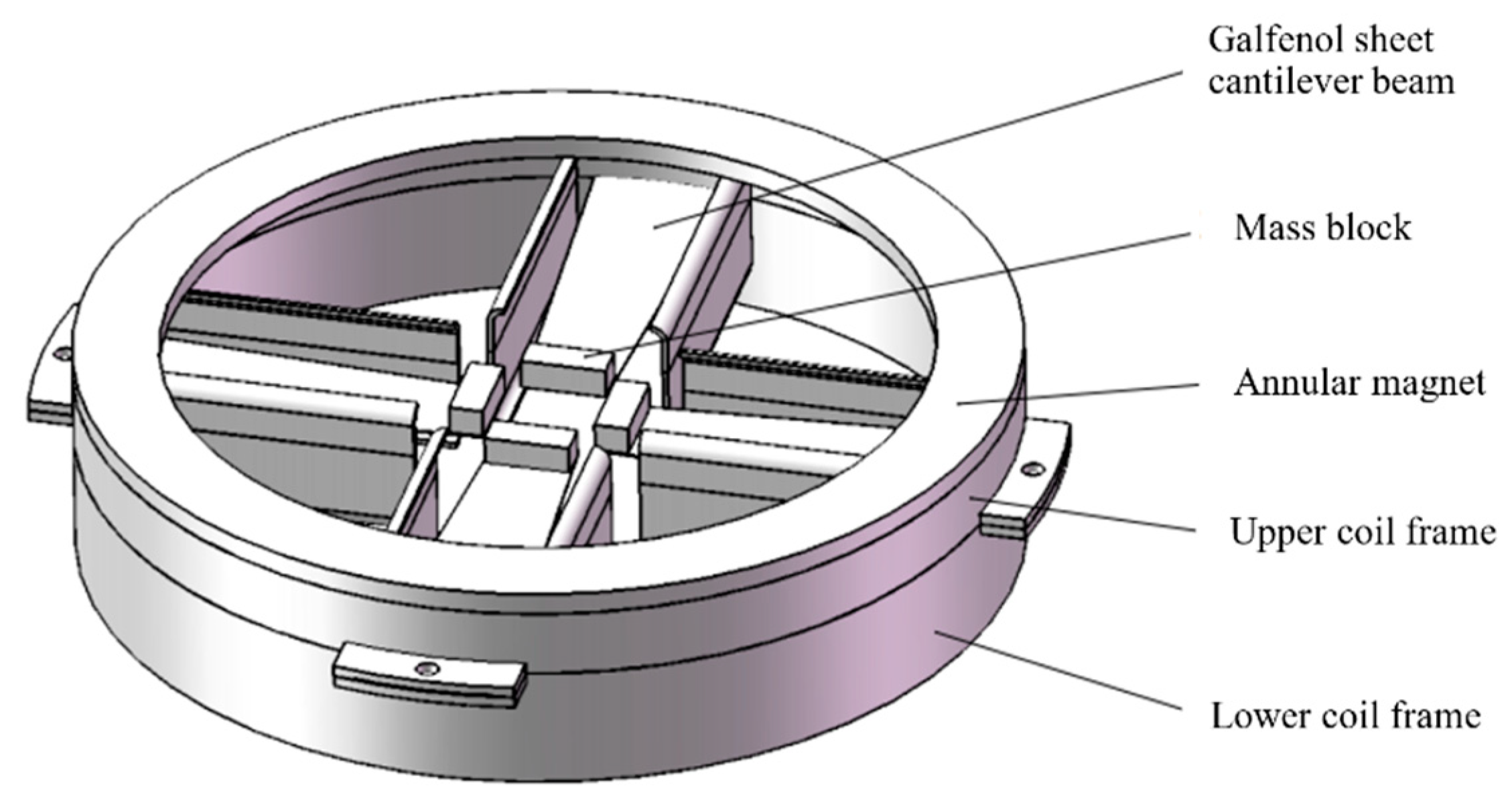


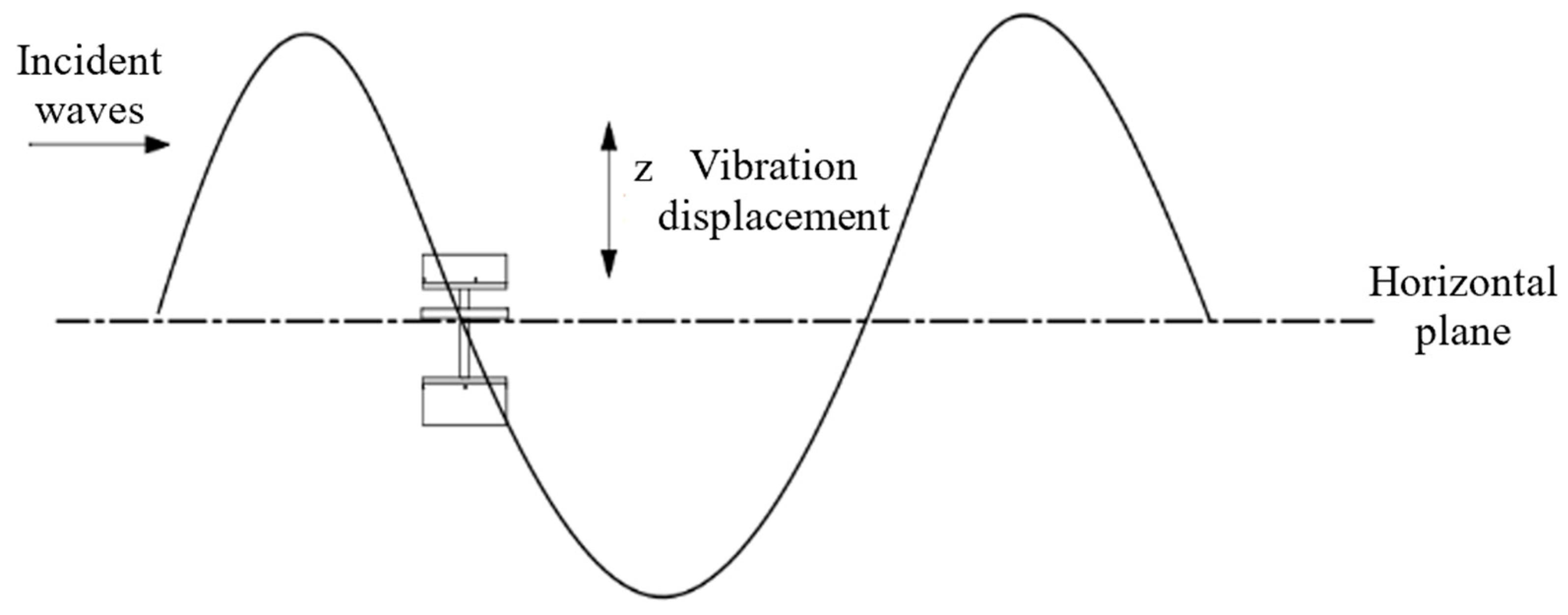
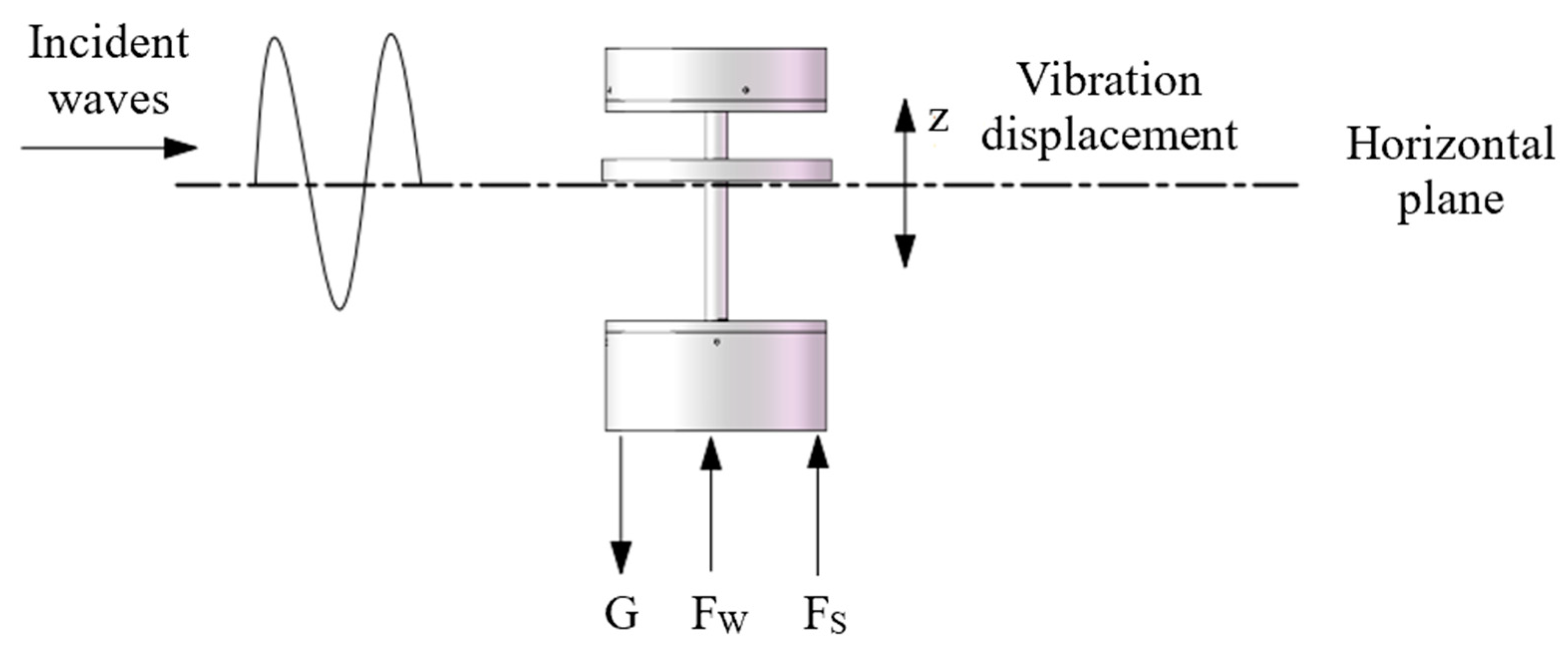
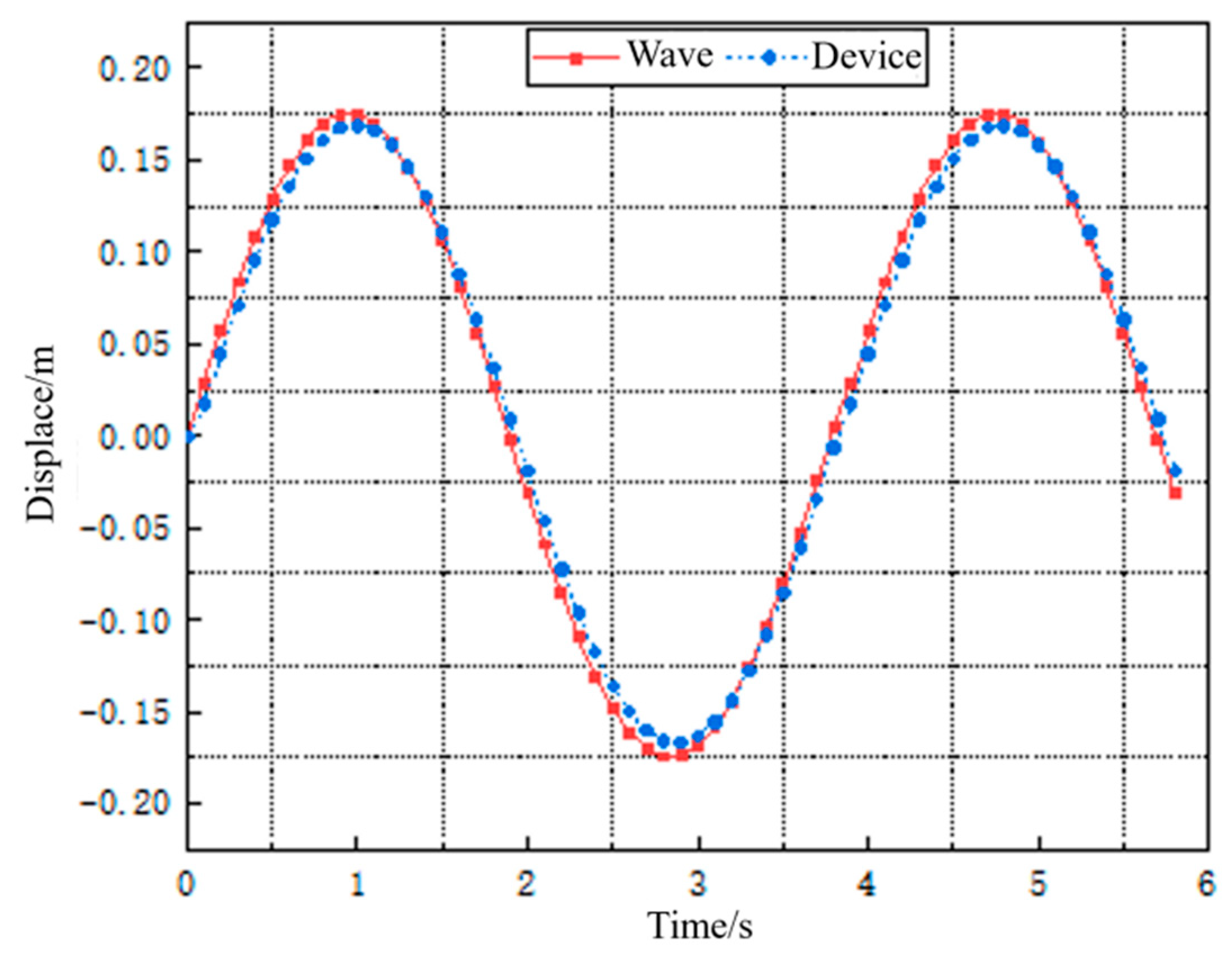
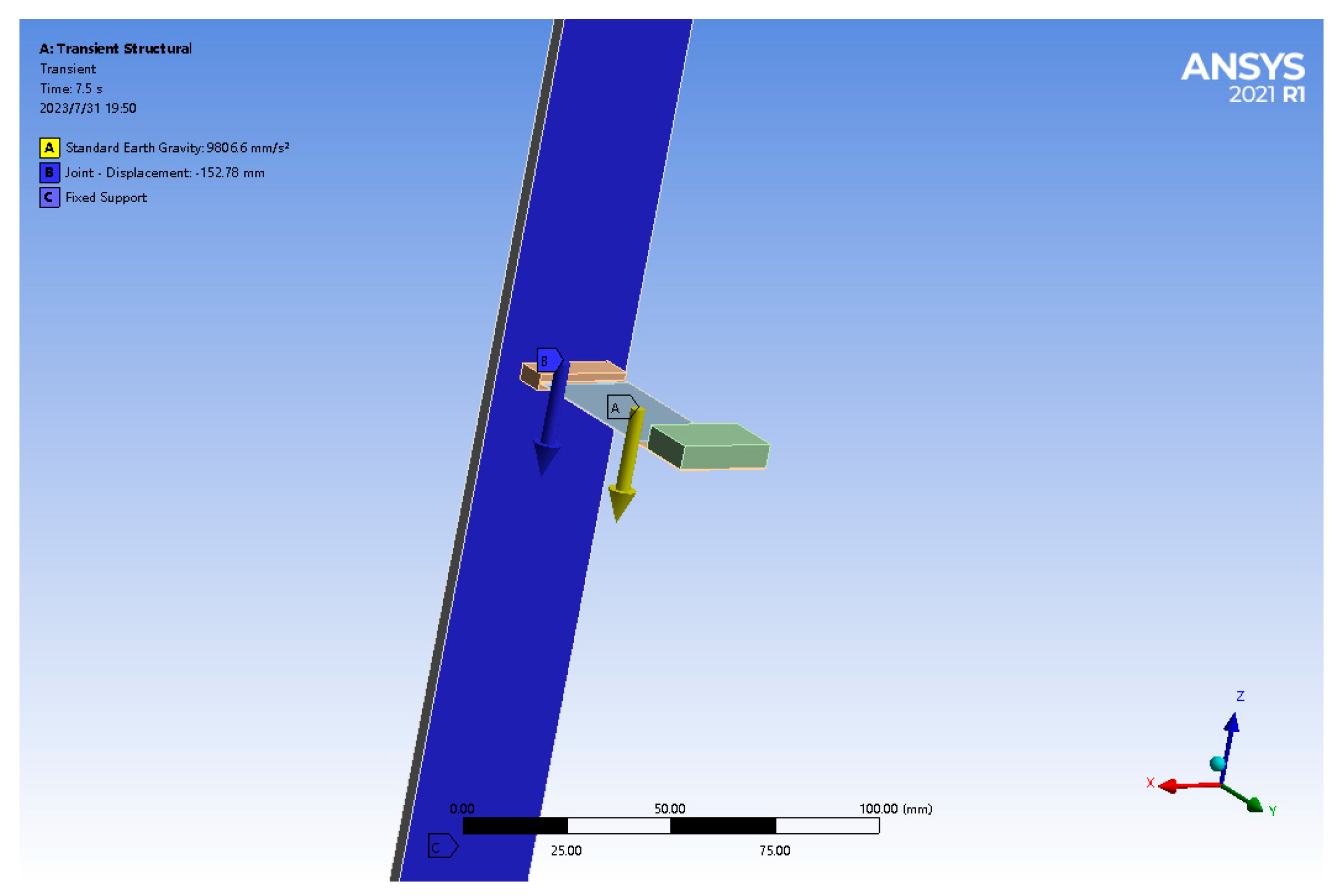
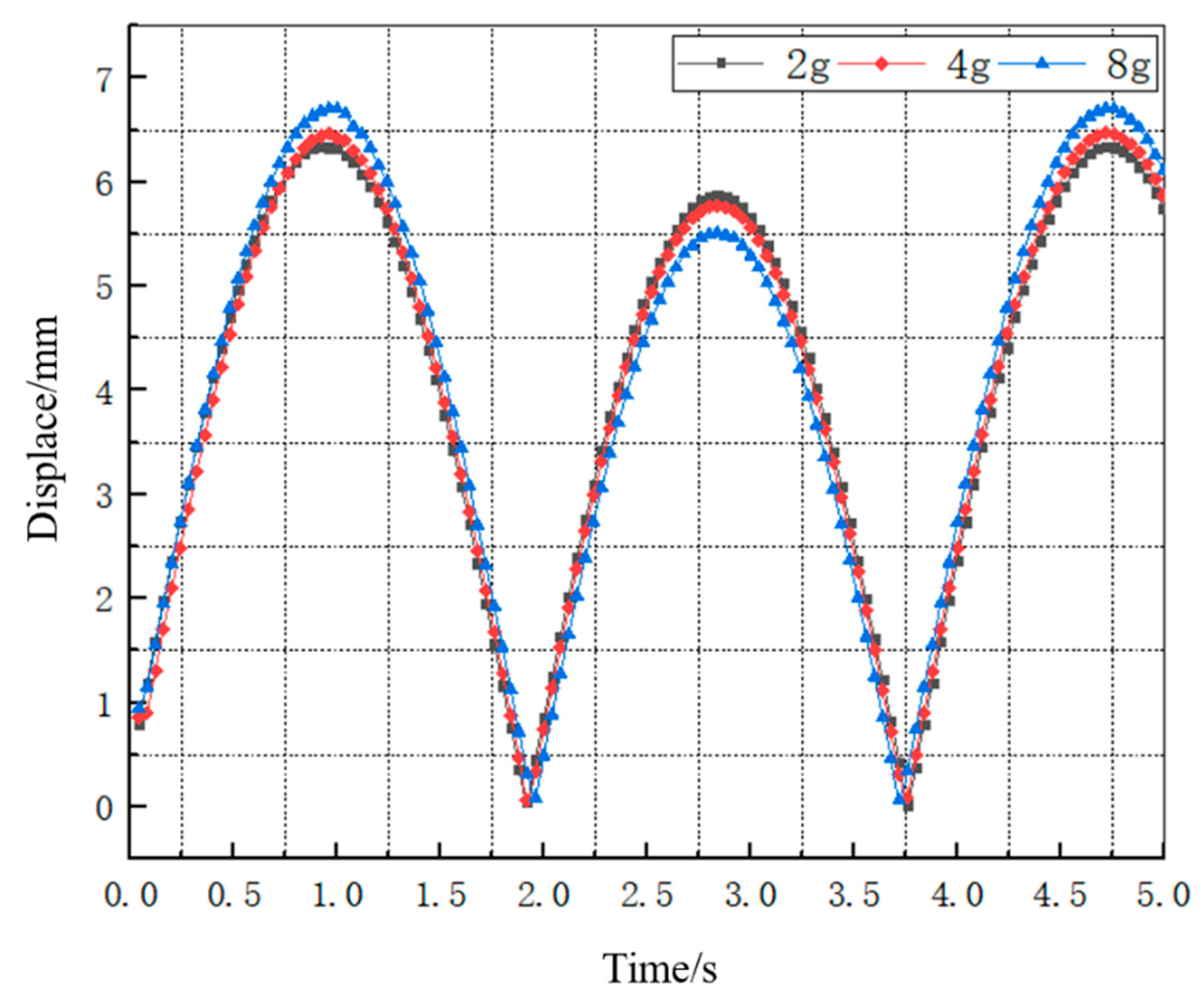
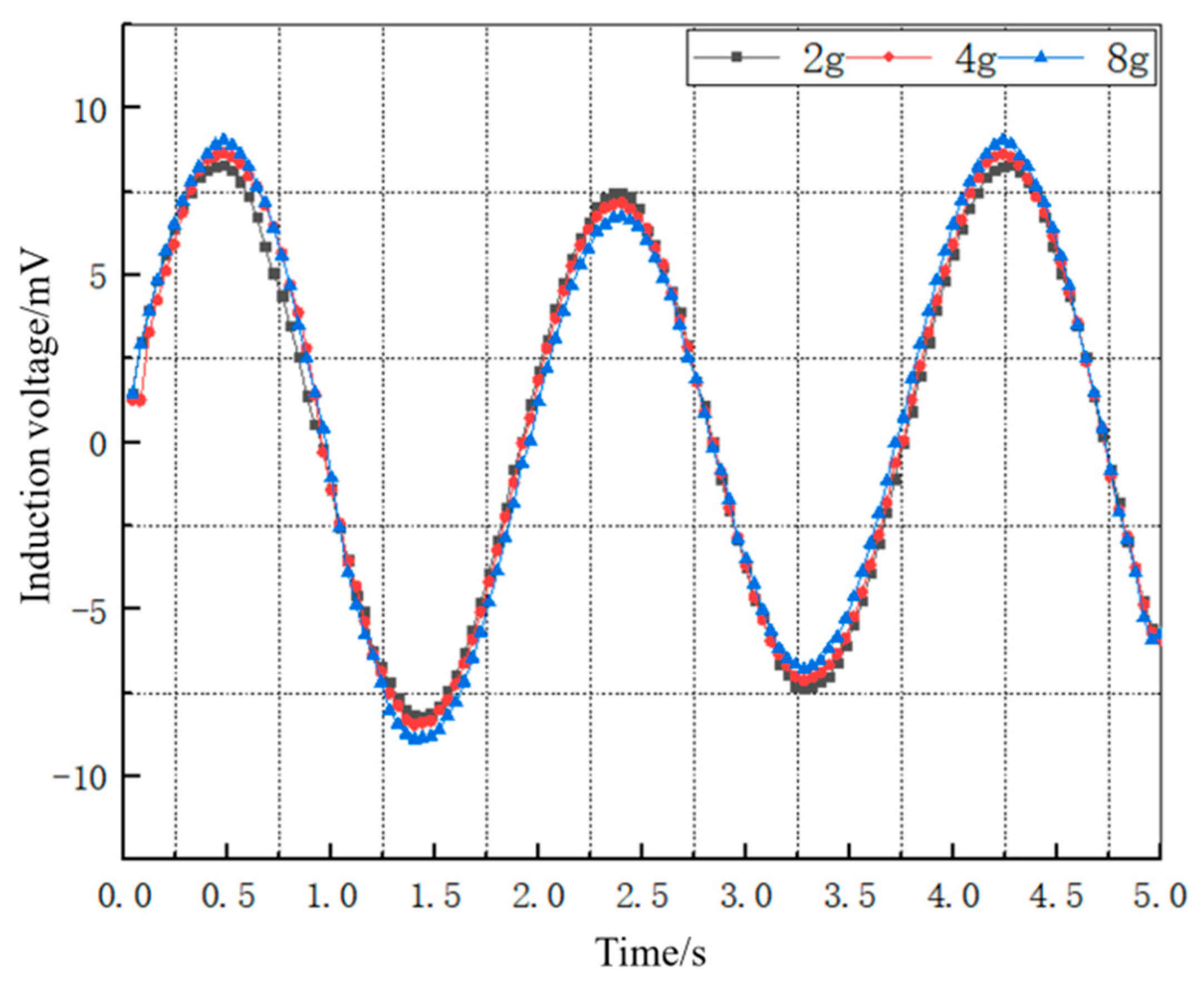
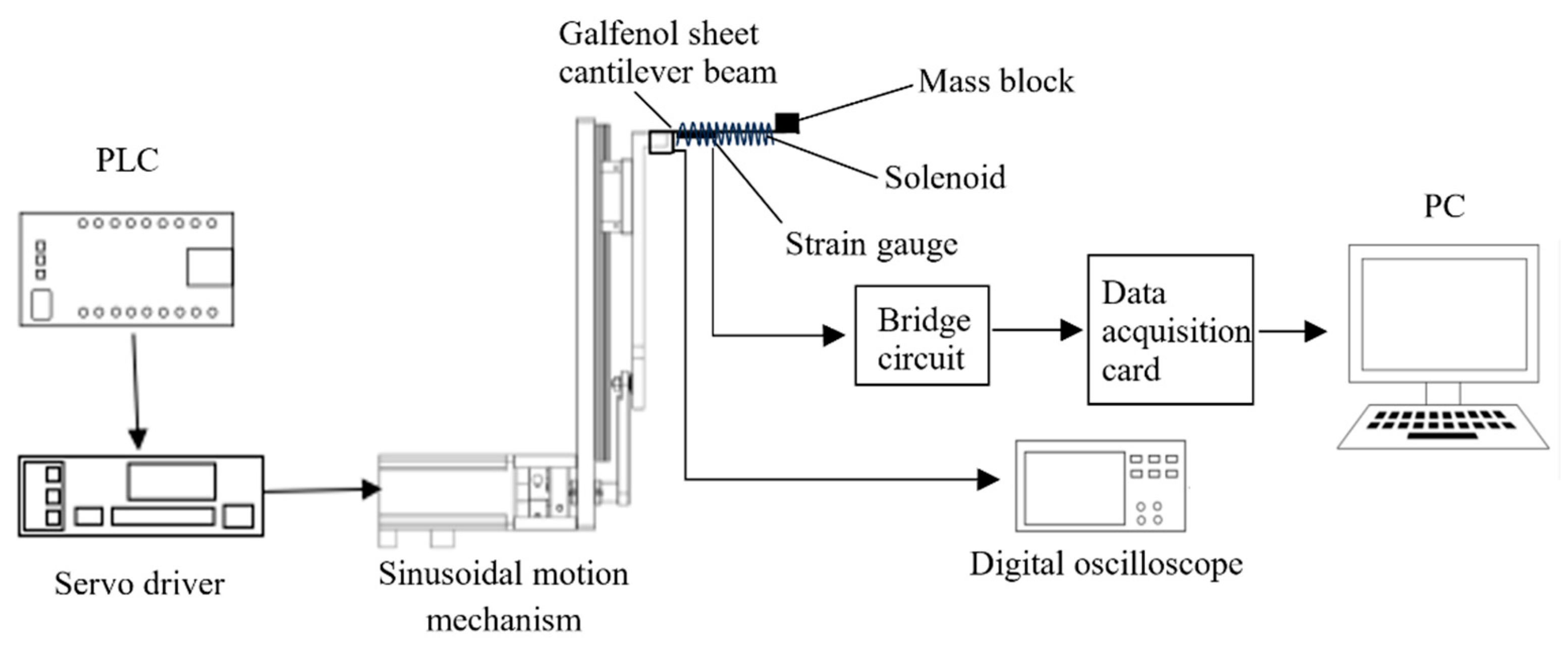
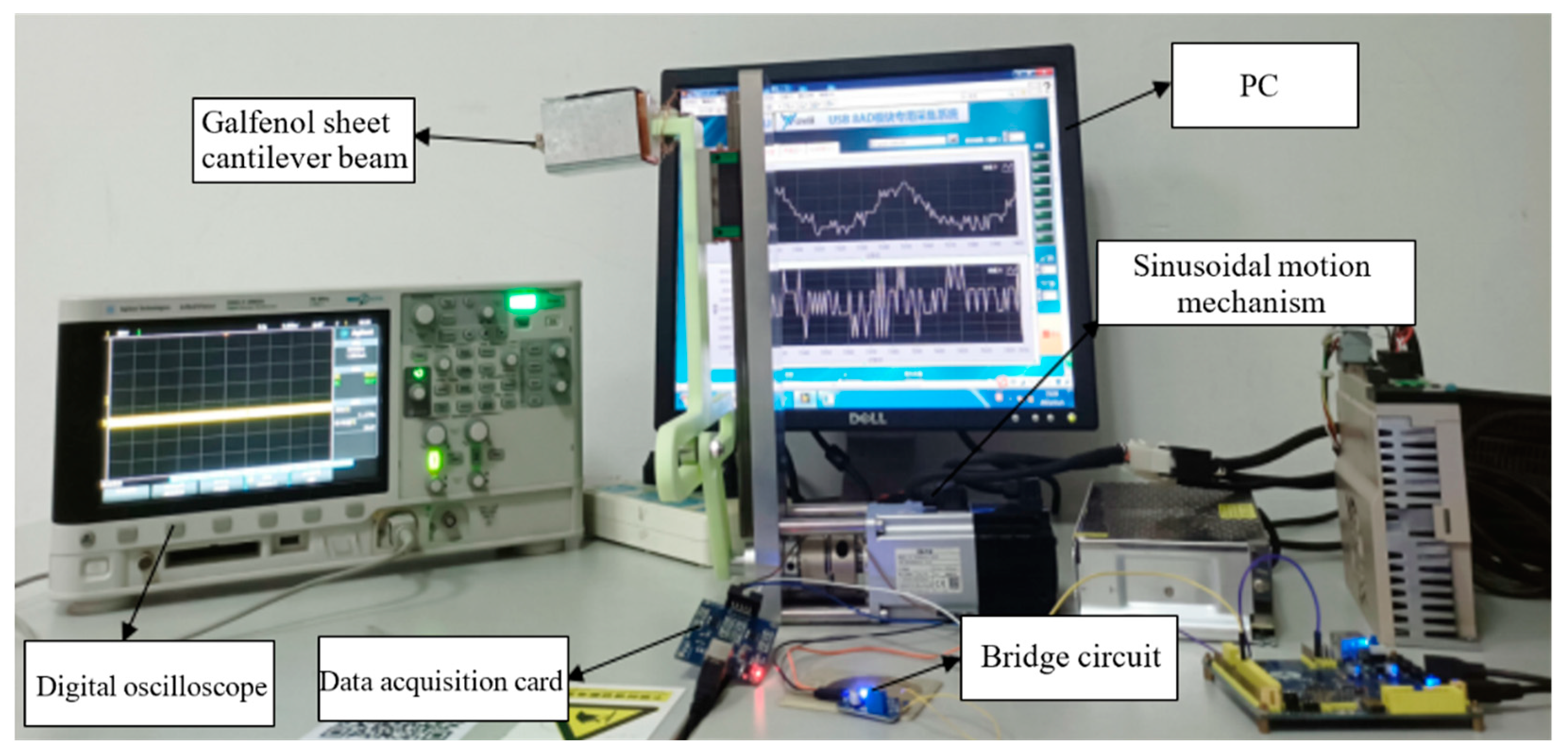
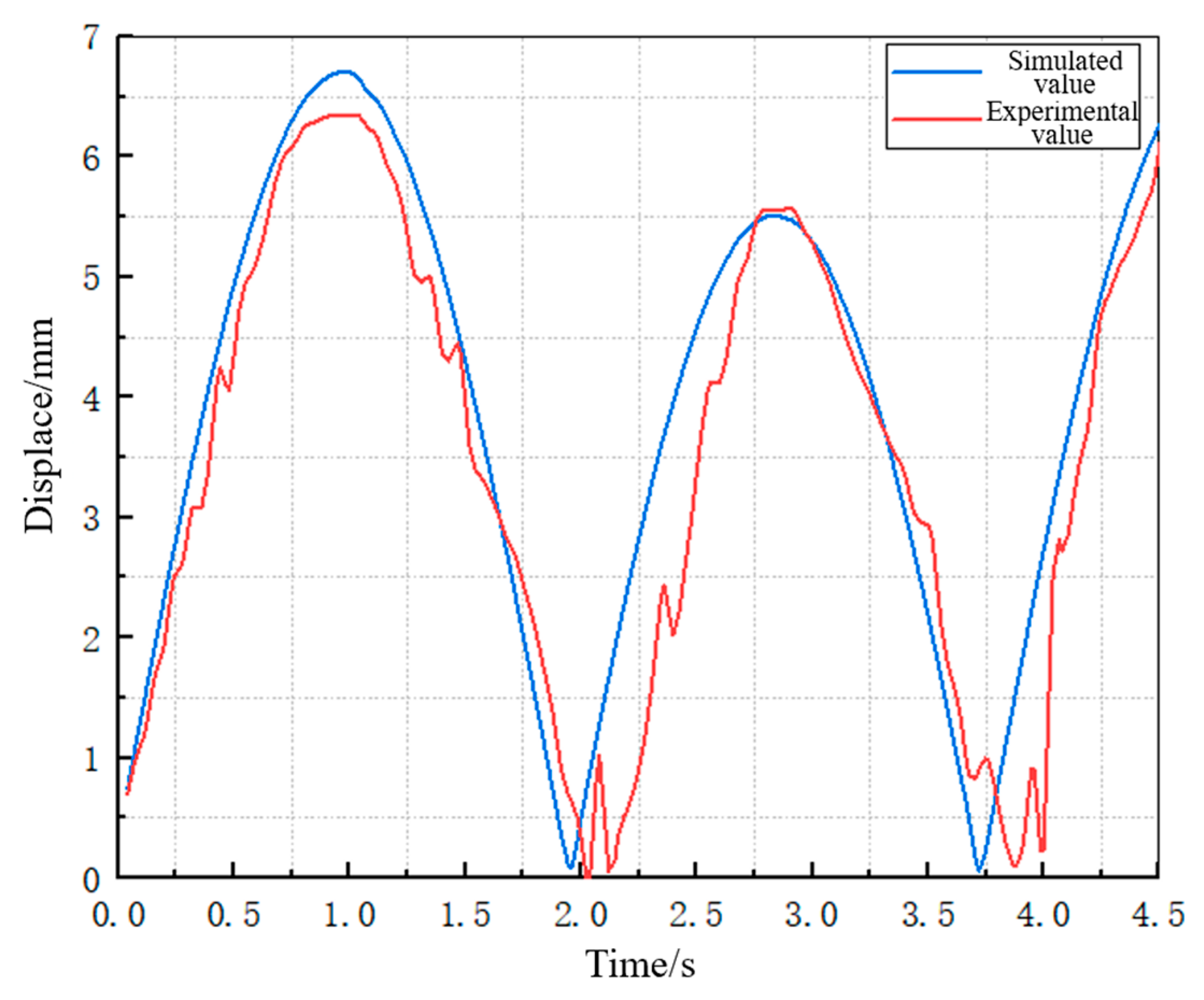
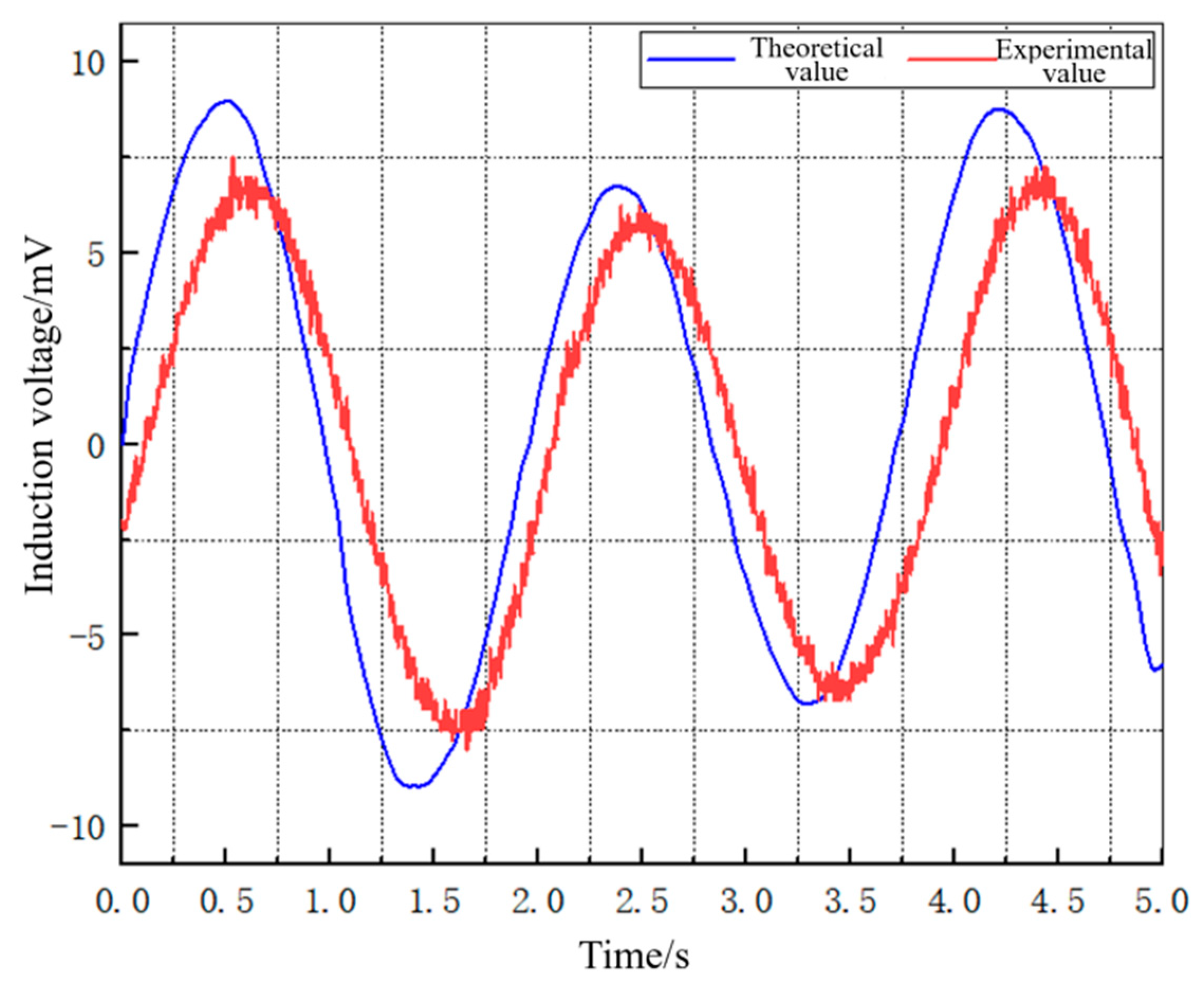
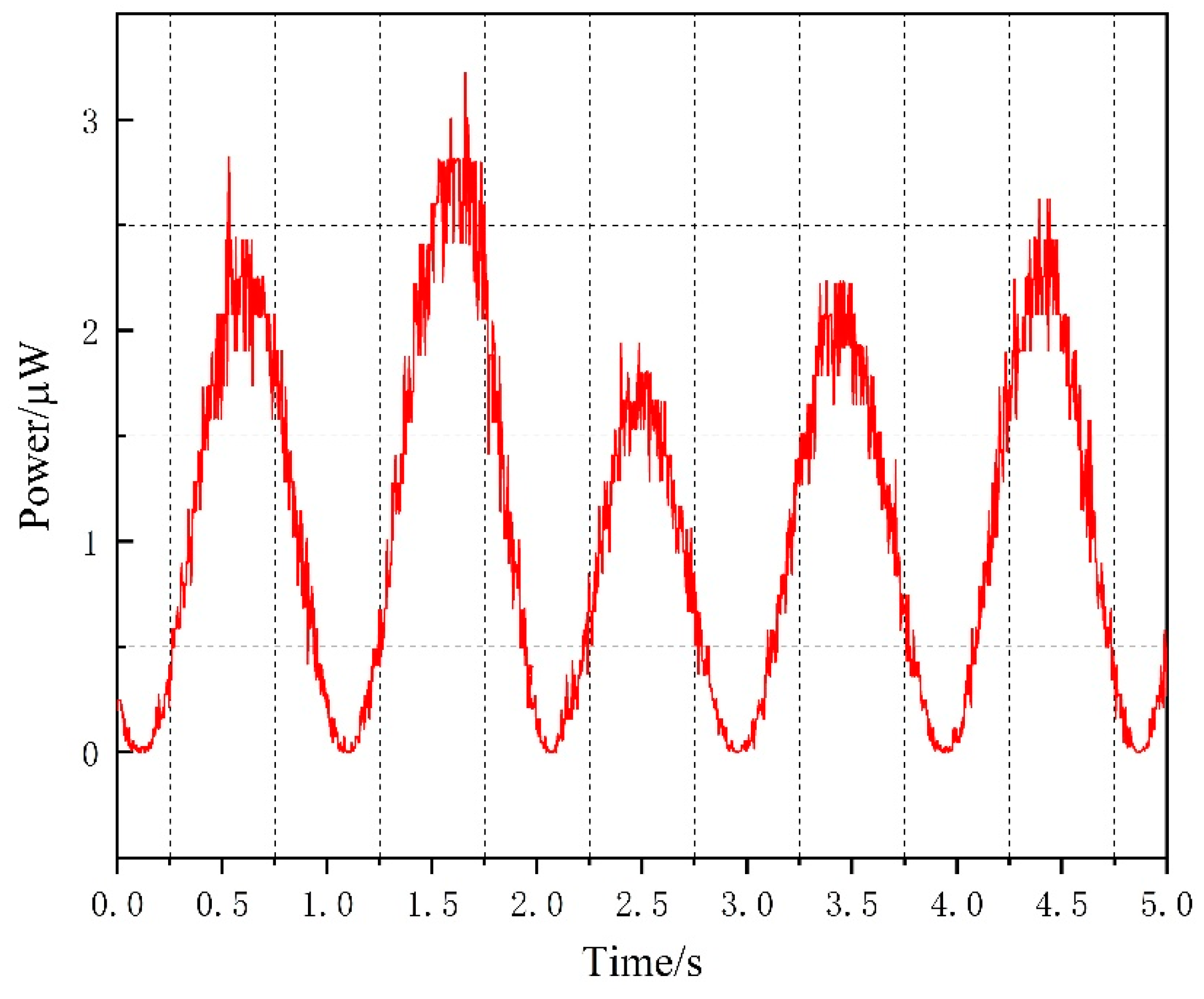
| Wave Height (m) | Periodicity (s) | Frequency (rad/s) | Wave Length (m) | Wave Number (k) |
|---|---|---|---|---|
| 0.349 | 3.784 | 1.66 | 22.3 | 0.28 |
| Model Parameters | Numerical Values |
|---|---|
| Saturation magnetization strength /(A/m) | |
| Hysteresis-free magnetization intensity factor | 7012 |
| Constant | 0.18 |
| Elastic modulus /(pa) | |
| Vacuum magnetic permeability | |
| Number of turns | 700 |
| Cross-sectional area /(m) | |
| Galfenol length /(m) | 0.05 |
| Compressed magnetic stress constants | 166 |
| Magnetic fields caused by Prestressing /(A/m) | |
| Saturated hysteresis (ppm) | 160 |
| Peak-Trough Sequence | Theoretical Values (mV) | Experimental Values (mV) | Absolute Errors (mV) | Errors |
|---|---|---|---|---|
| 1 | 8.96 | 7.51 | −1.45 | 16% |
| 2 | −8.93 | −7.75 | 1.18 | 13% |
| 3 | 6.73 | 6.23 | −0.5 | 7.4% |
| 4 | −6.88 | −6.36 | 0.52 | 7.5% |
| 5 | 8.75 | 7.24 | −1.52 | 17% |
Disclaimer/Publisher’s Note: The statements, opinions and data contained in all publications are solely those of the individual author(s) and contributor(s) and not of MDPI and/or the editor(s). MDPI and/or the editor(s) disclaim responsibility for any injury to people or property resulting from any ideas, methods, instructions or products referred to in the content. |
© 2023 by the authors. Licensee MDPI, Basel, Switzerland. This article is an open access article distributed under the terms and conditions of the Creative Commons Attribution (CC BY) license (https://creativecommons.org/licenses/by/4.0/).
Share and Cite
Jin, S.; Meng, A.; Li, M.; Xu, Z.; Wu, S.; Chen, Y. Modeling and Analysis of Wave Energy Harvester with Symmetrically Distributed Galfenol Cantilever Beams. Materials 2023, 16, 5585. https://doi.org/10.3390/ma16165585
Jin S, Meng A, Li M, Xu Z, Wu S, Chen Y. Modeling and Analysis of Wave Energy Harvester with Symmetrically Distributed Galfenol Cantilever Beams. Materials. 2023; 16(16):5585. https://doi.org/10.3390/ma16165585
Chicago/Turabian StyleJin, Sunyangyang, Aihua Meng, Mingfan Li, Zhenlong Xu, Shuaibing Wu, and Yu Chen. 2023. "Modeling and Analysis of Wave Energy Harvester with Symmetrically Distributed Galfenol Cantilever Beams" Materials 16, no. 16: 5585. https://doi.org/10.3390/ma16165585
APA StyleJin, S., Meng, A., Li, M., Xu, Z., Wu, S., & Chen, Y. (2023). Modeling and Analysis of Wave Energy Harvester with Symmetrically Distributed Galfenol Cantilever Beams. Materials, 16(16), 5585. https://doi.org/10.3390/ma16165585






